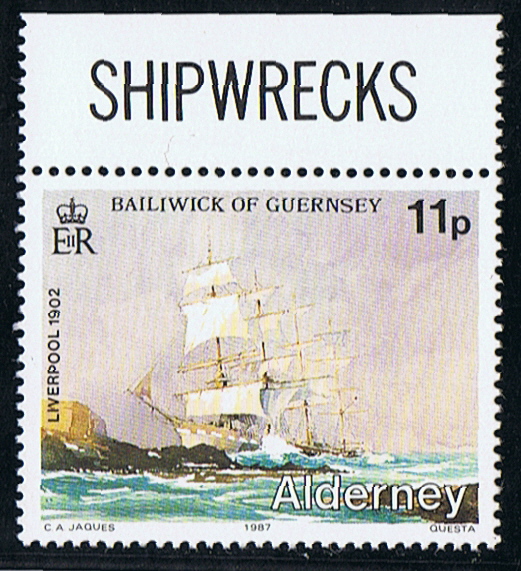
The four-mast steel ship was built under yard No. 182 by Russell & Co., Port Glasgow for R.W.Leyland & Co. (Leyland Line), at Liverpool.
07 December 1888 launched under the name LIVERRPOOL.
Tonnage 3.396 gross, 3.330 net, with a deadweight of around 6.000 ton. Dim. 101.54 x 14.54 x 8.04m.
Ship rigged.
When built was she the largest British four-master.
She was built for the jute trade from Calcutta, she could stow around 26.000 bales of jute, but when ready the trade in jute had declined, and her maiden voyage was from London to Melbourne.
09 March 1889 she sailed from London under command of Capt. Thomas Calder and after a passage of 88 days she arrived at Melbourne on 09 June. At this trip she carried 1 cabin and 10 steerage passengers.
02 September 1890 left for her second outward voyage from Frederickstadt, Norway bound for Hobson Bay, Australia where she arrived 12 December after a passage of 101 days.
Loaded during February and March, 29.353 bags of wheat, 5.045 bales of wool, 3.112 bag of flour, besides horns, bark, leather and tallow.
24 March 1891 sailed from Hobson Bay and via Cape Horn arrived 28 June at Gravesend, near London.
Later used in the trade between the U.K. and Calcutta.
1894 She made a good run to Calcutta after a passage of 88 days from Liverpool.
1899 Made an other good passage of 92 days from Liverpool to the Hoogly River, India.
22 February 1902 she left Antwerp under command of Capt Lewis and a crew of 34, loaded with a general cargo bound for San Francisco.
Due to heavy fog the ship stranded 25 January on the north part of Alderney, in the English Channel.
At the time she was under full sail, and the crash on the rocks broke her back. Her crew were saved but the LIVERPOOL was a total loss.
To prevent looting of the cargo watchmen were used, but slowly she was destroyed by the seas.
A consortium of 5 men bought the wreck of the LIVERPOOL for £250, and made a healthy profit of around £ 8.000 , she sold the cargo which consisted out of 1.800 ton timber, 700 ton cokes, barrels of cement, whisky and wine, marble slabs , soap and sulphur, also all sails, rigging, winches, anchors and lifeboats were sold.
In the inquiry on the stranding, Capt Lewis told around midnight of 24 February the LIVERPOOL was about 16 till 18 miles off Barfleur, during a light wind from the e.s.e. while the ship was steering a westerly course. At 01.00 a.m. they lost sight of the light of Barfleur due to fog. At 08.00 a.m. they took a sounding with a depth of 18 fathom, and the course was altered to w.n.w. At 10.00 am an other sounding was taken with a depth of 36 fathom. At noon breakers were seen right ahead, but the ship did not list more to her rudder, she drifted on the rocks in a position about 12 miles from the place they were thinking the ship was.
Capt Lewis was found guilty; the inquiry found that not sufficient allowance had been made for the indraught of the strong tide during the spring tides.
Alderney 1987 11p sg A32, scott 116.
Source; Log Book. The Last of the Windjammers by Basil Lubbock.
